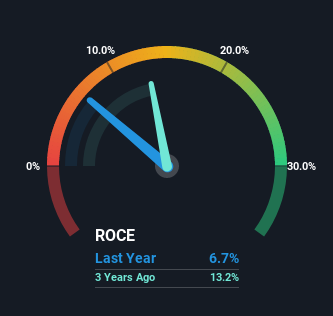Investors Met With Slowing Returns on Capital At Air T (NASDAQ:AIRT)
There are a few key trends to look for if we want to identify the next multi-bagger. Firstly, we'd want to identify a growing return on capital employed (ROCE) and then alongside that, an ever-increasing base of capital employed. Basically this means that a company has profitable initiatives that it can continue to reinvest in, which is a trait of a compounding machine. Having said that, from a first glance at Air T (NASDAQ:AIRT) we aren't jumping out of our chairs at how returns are trending, but let's have a deeper look.
Return On Capital Employed (ROCE): What Is It?
If you haven't worked with ROCE before, it measures the 'return' (pre-tax profit) a company generates from capital employed in its business. Analysts use this formula to calculate it for Air T:
Return on Capital Employed = Earnings Before Interest and Tax (EBIT) ÷ (Total Assets - Current Liabilities)
0.067 = US$9.7m ÷ (US$212m - US$68m) (Based on the trailing twelve months to December 2022).
Thus, Air T has an ROCE of 6.7%. Ultimately, that's a low return and it under-performs the Logistics industry average of 14%.
View our latest analysis for Air T
Historical performance is a great place to start when researching a stock so above you can see the gauge for Air T's ROCE against it's prior returns. If you'd like to look at how Air T has performed in the past in other metrics, you can view this free graph of past earnings, revenue and cash flow.
How Are Returns Trending?
The returns on capital haven't changed much for Air T in recent years. Over the past five years, ROCE has remained relatively flat at around 6.7% and the business has deployed 141% more capital into its operations. Given the company has increased the amount of capital employed, it appears the investments that have been made simply don't provide a high return on capital.
Our Take On Air T's ROCE
As we've seen above, Air T's returns on capital haven't increased but it is reinvesting in the business. Unsurprisingly, the stock has only gained 22% over the last five years, which potentially indicates that investors are accounting for this going forward. Therefore, if you're looking for a multi-bagger, we'd propose looking at other options.
If you want to know some of the risks facing Air T we've found 2 warning signs (1 shouldn't be ignored!) that you should be aware of before investing here.
While Air T may not currently earn the highest returns, we've compiled a list of companies that currently earn more than 25% return on equity. Check out this free list here.
Have feedback on this article? Concerned about the content? Get in touch with us directly. Alternatively, email editorial-team (at) simplywallst.com.
This article by Simply Wall St is general in nature. We provide commentary based on historical data and analyst forecasts only using an unbiased methodology and our articles are not intended to be financial advice. It does not constitute a recommendation to buy or sell any stock, and does not take account of your objectives, or your financial situation. We aim to bring you long-term focused analysis driven by fundamental data. Note that our analysis may not factor in the latest price-sensitive company announcements or qualitative material. Simply Wall St has no position in any stocks mentioned.
Join A Paid User Research Session
You’ll receive a US$30 Amazon Gift card for 1 hour of your time while helping us build better investing tools for the individual investors like yourself. Sign up here

